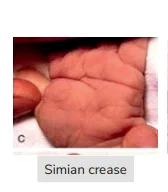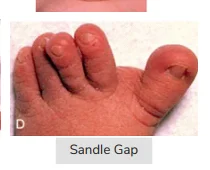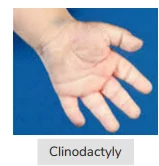Down Syndrome: Causes, Symptoms, Risk Factors, Diagnosis
Aug 2, 2023
Navigate Quickly
Causes Of Down Syndrome
Symptoms Of Down Syndrome
Is Down Syndrome Inherited?
Risk Factors Of Down Syndrome
Diagnosis Of Down Syndrome
Treatment Of Down Syndrome
Complications Of Down Syndrome

The genetic disorder known as Down syndrome is caused by faulty cell division, which results in a whole or partial extra copy of chromosome 21. This extra genetic material contributes to the physical traits and developmental defects of Down syndrome.
Depending on how severe a person's case of Down syndrome is, it might result in lifelong intellectual difficulties and developmental delays. It is the most prevalent hereditary chromosomal disorder and the main cause of learning disabilities in children. Along with other medical concerns, it commonly causes digestive and cardiac problems.
With the help of early therapies and more knowledge about Down syndrome, the quality of life for kids and adults with this condition can be significantly improved, and they can lead productive lives.
Causes Of Down Syndrome
Human cells normally have 23 sets of chromosomes. Each pair of your chromosomes is made up of one each from mother and father.
Down syndrome is brought on by abnormal cell division that is associated with chromosome 21. These errors in cell division result in an additional partial or complete copy of chromosome 21. This extra genetic material contributes to the specific traits and developmental problems associated with Down syndrome. The three distinct genetic variations that might cause Down syndrome are as follows:
- Trisomy 21. About 95% of Down syndrome cases are caused by trisomy 21, in which chromosome 21 contains three copies rather than the normal two in all cells. This comes up as a result of abnormal cell division that takes place either during the sperm cell's formation or the egg cell's formation.
- Mosaic Down syndrome. Rare cells with an extra copy of chromosome 21 are found only in a small percentage of individuals with this unusual form of Down syndrome. An uneven mixture of normal and defective cells is produced after fertilization by aberrant cell division.
- Translocation Down syndrome. Furthermore, if a section of chromosome 21 translocates (adheres to another chromosome), the down syndrome can manifest either before or during conception. In addition to their typical two copies of chromosome 21, these children additionally have extra chromosome 21 genetic material that is connected to another chromosome.
Environmental or behavioral factors are not known to contribute to Down syndrome.
Also read: Important Pathology Questions on Cell Injury – MCQs & Key
Symptoms Of Down Syndrome
Below are mentioned some of the symptoms of down syndrome:
- Incurved little finger (clinodactyly)
- Intellectual disability
- Congenital heart disease
- Congenital hypothyroidism
- Acute leukemia
- Alzheimer's disease (early onset)
- Atlantoaxial instability
- Absent Moro's Reflex
- Atresia of Duodenum
- Protruding tongue
- Round face
- Occiput flat
- Open, wide fontanelle
- Brushfield spots on Iris
- Brachycephaly
- Low (depressed) Nasal bridge, Low tone (hypotonia)
- Epicanthic fold, low-set ears, and dysplastic ears
- Mongoloid slant (oblique palpebral fissure) of eyes
- Simian palmar crease, sandle gap




Is Down Syndrome Inherited?
Most often, down syndrome is not inherited.. During the fetus' early development, there was an error in cell division that led to this condition.
Translocation Down syndrome can be handed down from parents to offspring. However, only a portion of the 3–4% of children with Down syndrome who have translocation do so because they received it from one of their parents.
When balanced translocations are inherited, the mother or father does not have any more genetic material but does have some altered genetic material from chromosome 21 on another chromosome. This indicates that although the person does not exhibit any indications or symptoms of Down syndrome, they are capable of passing on an imbalanced translocation to their offspring, which will result in the development of the condition.
Also read: Plasma Cell Dyscrasia & Flow Cytometry in Hematology
Risk Factors Of Down Syndrome
Some parents run a higher risk of having a child with Down syndrome. risk elements consist of:
- Advancing Maternal Age. Because older eggs have a higher risk of incorrect chromosomal division, a woman's odds of having a kid with Down syndrome rise with age.
- After the age of 35, a woman is more likely to become pregnant with a child who has Down syndrome. However, because younger women give birth to a greater number of kids, the majority of children with Down syndrome are born to mothers under the age of 35.
- Possessing the genetic rearrangement that causes Down syndrome. The genetic translocation for Down syndrome can be passed on to children by both sexes.
- Having one child that has Down syndrome. There is a higher chance that a couple will have another child with Down syndrome if they already have a kid with the condition and if they themselves have a translocation. The likelihood of having a second child with Down syndrome can be calculated with the assistance of a genetic counselor.
It can be easier to maintain a healthy lifestyle for persons with Down syndrome if they receive regular medical care and are treated for problems as they arise.
Diagnosis Of Down Syndrome
Based on the newborn's appearances a doctor might assume Down syndrome. A blood test called a karyotype test, which aligns up the chromosomes and identifies the presence of an extra copy of chromosome 21, can confirm this.
The Down Syndrome screening during pregnancy:
Regular prenatal screenings can determine whether your baby is likely to have Down syndrome. You might decide to have additional, more invasive testing to be sure if those results are positive or if you're at high risk.
You might have experienced the following during the first trimester:
- Tests on the blood. Your doctor will check the levels of the hormone hCG and the protein PAPP-A in your blood. Anything outside of the typical range could indicate a concern with the infant.
- If you have a high risk of developing Down syndrome, they may also check your blood for baby DNA so they may check for chromosome abnormalities.
- Ultrasound. The tissue folds at the back of your baby's neck will be measured by your doctor after they have examined a picture of your child. Down syndrome babies frequently have excess fluid in certain areas.
- You might have in the second trimester:
- A blood test. A triple-screen test or a quad-screen test detects additional components in your blood, such as the hormone estriol and the protein AFP. Your doctor can accurately predict the likelihood that your child will have Down syndrome based on these levels and the outcomes of the tests performed during the first trimester.
- Ultrasound. An improved ultrasound can reveal some of the physical characteristics of Down syndrome when your baby is more mature.
Before your child is born, other tests can detect Down syndrome by examining a sample of their DNA for an extra copy of chromosome 21:
- Sampling of chorionic villus (CVS). Using cells obtained from the placenta, this can be accomplished during the first trimester.
- Amniocentesis. Typically during the second trimester, fluid from the amniotic sac around the infant is collected.
- PUBS stands for percutaneous umbilical blood sampling. Using umbilical cord blood taken during the second trimester, this is also done.
Treatment Of Down Syndrome
Although there is no known treatment for Down syndrome, it is possible to assist your child realise their full abilities. The goal of treatment is to promote your child's physical and mental development. Possible course of treatment includes:
- Either occupational or physical therapy.
- Speech treatment.
- Taking part in educational programmes for specific needs.
- Addressing any underlying health issues.
- Wearing eyeglasses to correct vision issues or hearing aids to treat hearing loss.
Complications Of Down Syndrome
People with Down syndrome may experience a variety of problems, some of which get worse as they age, These issues can occur because of:
- Heart disorders. Heart problems. At birth, roughly half of people with Down syndrome have congenital heart abnormalities. As early as the first few months of life, surgery may be necessary for some potentially fatal cardiac abnormalities.
- Problems in the digestive (GI) system. Some children with Down syndrome experience GI abnormalities, which can include esophageal, gastrointestinal, tracheal, and anus abnormalities. There may be a higher chance of having digestive issues such GI obstruction, heartburn (gastroesophageal reflux), or celiac disease.
- Immunity disorders. People with Down syndrome are more likely to develop autoimmune illnesses, some types of cancer, and infectious diseases due to abnormalities in their immune systems.
- Sleep Apnea. Both children and adults with Down syndrome have a higher chance of developing obstructive sleep apnea due to soft tissue and skeletal abnormalities that cause airways to get blocked.
- Obesity. Compared to the overall population, those who have Down syndrome are more likely to be overweight.
- Spine-Related issues. Atlantoaxial instability is a neck condition in which one or more individuals with Down syndrome have the top two vertebrae out of position. They are at risk of catastrophic spinal cord damage because of this issue if their necks are extended too far.
- Leukemia. The risk of leukaemia is higher in young children with Down syndrome.
- Dementia. Signs and symptoms of dementia may start around age 50 in those with Down syndrome, who are also at significantly higher risk. Alzheimer's disease is more likely to progress if you have Down syndrome.
- Other issues. Along with seizures, ear infections, endocrine issues, dental issues, hearing and vision issues, and hearing and vision loss, down syndrome may also be linked to various medical diseases.
Also read: Blood Groups and Storage in Blood Banking
Download the PrepLadder App and get the best neet pg online coaching with world-class video lectures, QBank, Mock Tests and more!
Download PrepLadder's best app for neet pg preparation for Android
Download PrepLadder's best app for neet pg preparation for ios

PrepLadder Medical
Get access to all the essential resources required to ace your medical exam Preparation. Stay updated with the latest news and developments in the medical exam, improve your Medical Exam preparation, and turn your dreams into a reality!
Top searching words
The most popular search terms used by aspirants
- Medical PG Pathology
- NEET PG Pathology
- NEET PG Pathology Preparation
PrepLadder Version X for NEET PG
Avail 24-Hr Free Trial